|
Liquid Image Wide Angle Scuba Series HD322
High Definition video in a full-function scuba mask gets even better with wide angle lens
(by Conrad H. Blickenstorfer and Carol Cotton)
It's hard to believe that it's been three years or so since we first came across the Liquid Image video masks that combine a camera with a scuba mask and can even accommodate dive lights. Since then, we've taken various models of the Liquid Image mask on dive trips all over the world. By now, the unusual masks have become a standard part of our dive gear and I would't go on a trip without one. The Liquid Image masks come in various models suitable from snorkeling all the way to advanced diving. In this article we'll describe our experience with the Liquid Image Scuba Series Wide Angle HD322, where "HD" stands for High Definition.
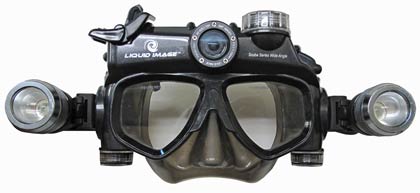
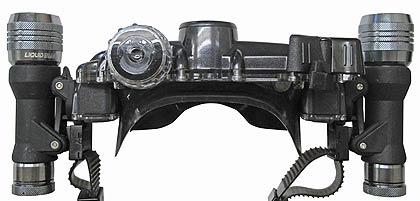
In essence, what you get here is a fully functional scuba mask that has a 720p high definition video camera built right into the mask. The camera, which can also take 5 megapixel still pictures, records onto a memory card of up to 32GB capacity. The whole deal is powered by four AAA batteries, two on each side of the mask. For low light situations, Liquid Image offers optional LED torch lights that can be attached to the mask. And there are filters to correct for various water conditions.
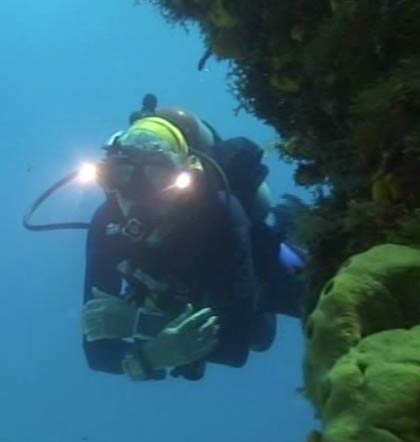
Yes, it looks unusual, and the Liquid Image mask is a surefire attention getter and conversation starter wherever you take it, even several years after its introduction. But let me state right upfront: The Liquid Image mask is not a toy. It is a serious product that can be used for underwater cinematography and documentation, and the mask itself works as well as any scuba mask I've ever used. And I say that based on considerable experience with the mask. We've used it in cold, murky water in San Diego's "Wreck Alley" at depths to 100 feet, we've used it diving with sharks at depths to 120 feet off the Caribbean islands of Turks and Caicos, we used it snorkeling with whale sharks off Isla Mujeres in Mexico, we used it playing with sea lions at the Coronado islands, and giant manta rays at Socorro and San Benedicto, we used it diving in Lake Tahoe at an altitude of 6,200 feet, and we used it drift and wreck diving off Cozumel in Mexico. The Liquid Image video masks—which start at under US$100 for the Explorer Series for snorkeling and range to the top-of-the-line Wide Angle HD322 that lists for US$349—have never let us down.
How does the camera mask work?
How do you operate a camera that is built into your mask? For such a product to work, it had to be simple. And it is. 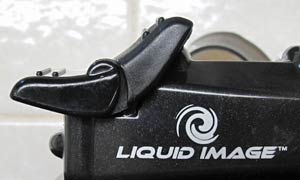 All mask functions are controlled by a single rocker on the upper right side of the mask. With the mask on, depressing the rocker to the left handles the Power/Mode function, depressing it to the right is Shutter/Select. The Power/Mode button turns it on and off and toggles between the still image and the video mode. The Shutter/Select button, takes pictures or starts and stops recording. To turn the camera off, you hold down the Power/Mode button for a second or so. That's it. All mask functions are controlled by a single rocker on the upper right side of the mask. With the mask on, depressing the rocker to the left handles the Power/Mode function, depressing it to the right is Shutter/Select. The Power/Mode button turns it on and off and toggles between the still image and the video mode. The Shutter/Select button, takes pictures or starts and stops recording. To turn the camera off, you hold down the Power/Mode button for a second or so. That's it.
The camera mask has no other adjustments, settings or functions at all. And since you're viewing things through the mask, there is also no conventional viewfinder or preview LCD. 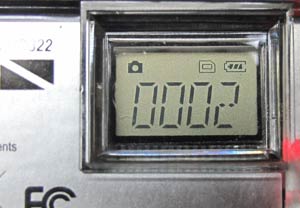 The camera mask does have a small status LCD that shows the mode the camera is in (still/video), whether a memory card is present, remaining battery life, and the number of files in storage. You can, however, not see the LCD while you are wearing the mask. The camera mask does have a small status LCD that shows the mode the camera is in (still/video), whether a memory card is present, remaining battery life, and the number of files in storage. You can, however, not see the LCD while you are wearing the mask.
So how do you know the camera is turned on and what mode it is in? 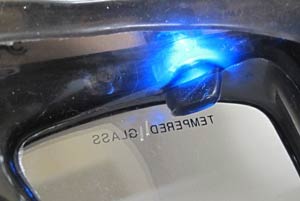 That's what the status light is for. The control light is designed so that it can be seen with the mask on or off. When you turn the camera on, the light is red and indicates that the camera is in still image mode. Push the rocker to video mode, and the light turns blue. Push the shutter to start video, and the blue light blinks until you push the shutter again to end recording video. That's what the status light is for. The control light is designed so that it can be seen with the mask on or off. When you turn the camera on, the light is red and indicates that the camera is in still image mode. Push the rocker to video mode, and the light turns blue. Push the shutter to start video, and the blue light blinks until you push the shutter again to end recording video.
That's all there is to operating the Liquid Image mask.
For storage, the mask uses a microSDHC card.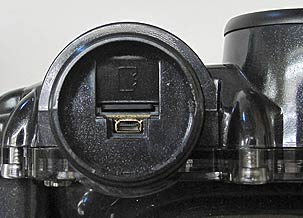 microSD cards are tiny, less than a quarter the size of a standard SD memory card, which is already small. However, you can get microSDHC cards in capacities of up to 32GB, and 8GB cards (good for about four hours of video or thousands of pics) cost less than US$20. To view pictures or video, you can either use a microSD Card adapter with your computer, or connect the video mask via included cable (see mini USB connector underneath the memory card slot). microSD cards are tiny, less than a quarter the size of a standard SD memory card, which is already small. However, you can get microSDHC cards in capacities of up to 32GB, and 8GB cards (good for about four hours of video or thousands of pics) cost less than US$20. To view pictures or video, you can either use a microSD Card adapter with your computer, or connect the video mask via included cable (see mini USB connector underneath the memory card slot).
Basic specs
As far as specs go, the camera mask can shoot either 2560 x 1920 pixel still pictures or 720p High Definition video. 720p means 1280 x 720 pixel resolution and therefore isn't the same as the standard 1080p HD video on TV, which is 1920 x 1080 pixel. The lens is fixed (no zoom or auto-focus) and is supposed to focus on subjects between about 1.7 and 10 feet, aperture is F/2.8, ISO sensitivity is 100-200, shutter speed between 1/16 and 1/1000th of a second, and white balance is automatic. There is no zoom or image stabilization.
What's different with the HD322?
What's the difference between the standard HD mask and the Wide Angle one? From what I can tell, apart from the color of the mask frame, it's mostly the significant difference in the lens angle. The standard mask has a viewing angle of 54 degrees, the HD322 one of 135 degrees. Now what does that mean? When still photographers talk about wide angle lenses, they generally use the camera's focal length. Going back to the olden days of 36 x 24 mm film, a "normal" lens had a focal length of about 50 mm, and anything less than 35 mm was considered "wide." When the wholesale switch to digital cameras happened, camera manufacturers continued to provide the "35 mm equivalent" focal length of a camera lens, even though almost all digital camera imagers are much smaller than 36 x 24 mm film. When I have my photographer's cap on, a camera's zoom is "wide" when it starts at 28 mm equivalent or less.
Things are different in the new world of pocket camcorders. There you will often find a lens described as having an angle of so and so many degrees. The angle describes the field of view. The larger the angle, the more the lens sees, up to a full 180 degree "fisheye" effect. The good thing about a wide viewing angle is that you see more, the bad thing that what you see can get distorted. From our prior experience with Liquid Image masks, we felt that the 54 degree angle of the standard mask was not wide enough for a camera without viewfinder. Sure, after a while you learned how to look at things to get them in the camera's field of vision, but all too often you simply missed the subject.
The pictures below show the difference between the wide-angle HD322 (left) and the regular HD320 (right). While the very wide angle makes for fisheye distortions in straight lines, that's less of an issue underwater where the much wider angle definitely works significantly better.
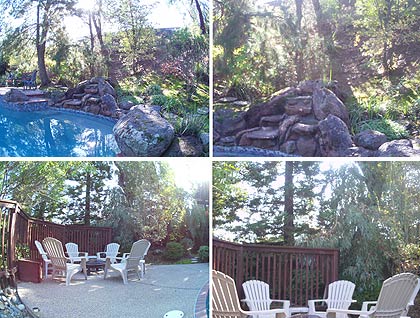
How does the mask itself feel?
Every diver knows how important it is to have the right mask. A mask that leaks or doesn't fit right can spoil or ruin an entire dive, and using the video mask means you have to leave your own regular mask behind. That's quite a leap of faith. The biggest concern therefore is whether the mask part of the camera mask is good enough and works for you. The answer is, it is good enough and then some, but every face is different and what might work for one person may not work for another. That's why Liquid Image offers the Wide Angle mask in midsize (HD322) and large (HD323) versions.
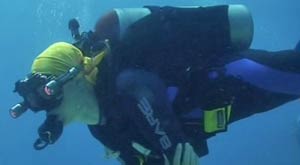 The mask itself is an attractive and very functional dual lens design. It consists of a low-volume silicone skirt/nose pocket that is attached to the sturdy plastic frame that includes the tempered glass lenses, the camera mechanism, battery pods on either side, and strap mounts. About the only problem I had with it was that the nose cutout of the frame occasionally pressed against the ridge of my nose. The mask itself is an attractive and very functional dual lens design. It consists of a low-volume silicone skirt/nose pocket that is attached to the sturdy plastic frame that includes the tempered glass lenses, the camera mechanism, battery pods on either side, and strap mounts. About the only problem I had with it was that the nose cutout of the frame occasionally pressed against the ridge of my nose.
But is the mask part of the Liquid Image videomask truly for real? We had already found our answer in earlier test dives where we took the lesser and largely untested 33-foot rated camera mask Model 310 into the frigid, murky Pacific waters off San Diego and down to the wreck of the Coast Guard Cutter Ruby E. that rests in 85 feet of water. Despite grossly violating that mask's depth rating, the mask passed with flying colors. With the exception of different coloring, the HD322 looks and feels the same as the standard video mask rated at just 60 feet, and so we had no doubt that it would work well.
Testing the Scuba Series 322 on the C58 wreck off Cancun
We took two HD322 masks on a weeklong dive trip to Cancun and Isla Mujeres in Mexico and wore the masks on most dives. As on prior dive trips with Liquid Image videomasks, the masks performed flawlessly.
Below is a screenshot of the Uwatec dive computer log of a 45 minute dive off Cancun to the wreck of the Mexican mine sweeper C58. Water temperature was a nice 82 degrees, visibility good, and we bottomed out at about 80 feet. There was no mask leaking or any malfunction.
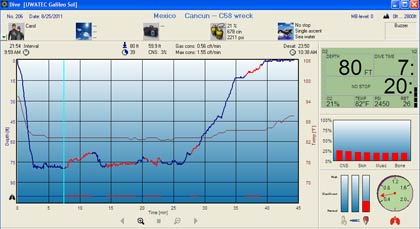
The mask is comfortable to wear and the smoked silicon skirt virtually eliminates distracting light and glare while still leaving the red and blue status lights clearly visible. And the rocker that operates the camera's two buttons works much better than having to push the buttons directly (as was the case with the 310 model).
Using the Scuba Series 322 to snorkel with whale sharks
While in Cancun, we spent two days snorkeling and swimming with whale sharks off Isla Mujeres. Whale sharks can be over 40 feet in length, weigh almost 40 tons, and go back some 60 million years. They pose no danger to divers, and they can be observed as they are slow swimmers. When we got there after a one hour boat ride, it was obvious that we had hit the whale shark jackpot. There were several dozens and perhaps over a hundred, and snorkelers from perhaps 40 boats.
The picture below is a screen grab from video we shot with the HD320 while swimming along with one of the many whale sharks.
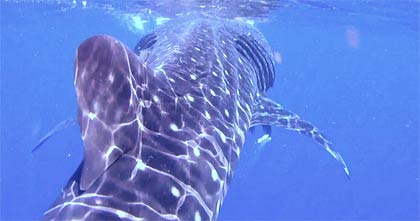
Impressions
Here are some of the comments we recorded on the Liquid Image HD322 mask based on about a dozen dives in Cancun and Isla Mujeres as well as impressions with prior versions that share the general concept. Most of our dives lasted about an hour and depths ranged from 60 to 120 feet as well as snorkeling.
- Overall feel — It felt both liberating and sort of weird not to have anything in my hands. I had to constantly remind myself that I indeed was using a camera.
- Excellent mask — The mask part is really terrific. The mask never leaked and worked every bit as well as an expensive dedicated dive mask. Even divemasters commented on that. This is really a major selling point to serious divers who may ask if the mask itself is for real.
- Cross Hatches — Earlier Liquid Image masks we tested had a cross hatch on each mask lens that were meant to help you frame a subject and show you roughly what the camera is recording. We got used to them, but in actual use they remained mildly distracting. The HD322 doesn't have the cross hatches anymore, and it also doesn't need them because of its much wider recording angle.
- Optics — I always felt the viewing angle of earlier Liquid Image masks was too narrow. The HD322's 135 degree wide viewing angle makes it much easier to capture what you want. The stated focus range of the mask is 1.7 feet to 10 feet. With a conventional camera we like to get much closer for macro shots, but 1.7 feet is probably close enough when the camera is on your face. Subjects beyond a few feet no longer look high-def, but that's mostly due to diminishing light.
- Buoyancy — I initially wondered what the mask's buoyancy might be. The mask is surprisingly light weight, weighing only slightly more than a regular mask. As it turned out, the mask wasn't positively buoyant and it felt no different from a regular mask. Even with the fairly heavy lights mounted to the mask, you hardly feel it under water.
- Lights and operation — Some commented they couldn't see the red and blue lights without readjusting the mask. True, but it didn't bother me much. And I found the on/off and mode switch rocker easy and intuitive to use.
- Bubbles — Since the camera lens is in the middle of the mask, you often see bubbles in the video. That is distracting, and the only way around it is to either move so the bubbles go elsewhere, or hold your breath while you record. This is probably the single biggest conceptual problem with the video mask design.
- Fogging — All masks tend to fog up (which is why you use mask defog), and new masks need to a good initial cleaning to remove production process residues. We noticed that most of our Liquid Image masks also tended to fog up on the upper left side, which most likely stems from the heat generated by the circuitry above it.
- Batteries — We often simply recorded entire dives. That way, four expensive Lithium AAAs run down quickly (we got a day and a half, or perhaps six dives). One divemaster commented that this makes it too expensive for him to use. Rechargeable AAAs would be an answer, or, even better, some sort of small digital camera-style rechargeable battery.
- File sizes — Recording 720p video takes about 2GB per hour, so an 8GB microSD card is good for four hours of video. That's excellent and a testimony to the really wonderful H.264 compression standard.
- Playback — Playback of hi-def video can be an issue on less powerful hardware. Unlike the older Video Mask 310's 720 x 480 D1 video that creates .AVI files that play back smoothly and without any slowdown on even modest hardware (such as our older netbooks we used), the H.264 files need powerful hardware for playback.
- 720p — Time moves on and most devices now do 1080p. Liquid Image likely will follow, but 720p is still plenty of resolution (standard DVDs, for example, only have 480p).
Picture and video quality
The quality of the still pictures and video we got out of the Liquid Image HD322 mask ranged from very good to very ho-hum. The technology is inherently capable of delivering sharp, vibrant still pictures and excellent high definition video. But getting that high quality requires understanding how this unique camera works and taking into consideration that taking pictures and shooting video underwater is simply much more complex than shooting on dry land.
Light is all-important. Without enough light, underwater video all looks greenish and low-res, and things get worse the deeper you go. You can record decent video at 120 feet, but it will look nothing like the glorious highdef burst of colors you'd want. That's just not possible.
Because the recording angle is so much wider, aiming the camera is much easier with the wide angle HD322 than with narrow angle versions of the mask. We didn't miss the crosshairs of earlier models, but it still takes practice so you don't end up with footage that is either too high or too low. The limited focus range (1.7 feet to ten feet) combined with the low light conditions prevalent on most dives means things are often not in focus, only offering the occasional peek at glorious color and sharpness.
You wouldn't think so, but it's amazingly difficult to keep one's head still. Even after plenty of practice with the video mask, I still find that I move my head too much and don't stay put long enough to take the kind of still scenes that make for good viewing later. Not much that can be done here as it is a given issue with a mask-mounted camera. And since the mask rattles a bit when one exhales and there can be bubbles on video, it works best shooting short scenes while holding your breath (which, of course, they tell you to never do when diving).
Most still cameras designed for underwater use have special underwater modes that correct for the gradual loss of color the deeper you go. Without underwater color correction, anything deeper than a few feet looks intensely green. Liquid Image offers a blue water and a green water filter and this latest HD322 version seemed to have some sort of automatic white balance adjustment that was, however, not fully functional yet and at times resulted in sudden excessive red at depth.
Still image quality was often quite unexceptional. The CMOS imager ought to be able to do much better (and it can, as evidenced by the occasional brilliantly sharp shot). As is, I would not rely on the HD322 for stills.
Let there be light: the fabulous LED side-mount torches
We like the optional Liquid Image dual head-mounted dive lights so much that we consider them one of the best features of their video masks.
The nicely crafted aluminum lights are five inches long, weigh 6.8 ounces each including batteries and mounting brackets, and use a couple of special CR123A 3 Volt 1,400mAh Lithium batteries. First I was concerned about the somewhat unusual batteries, but they are fairly inexpensive and not too hard to find, and they last about ten hours, which means they are good for a good dozen night dives, and many dozens, or even hundreds, of daytime dives where you don't have the lights on all the time.
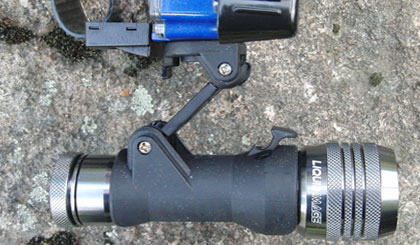
Here are our observations after using the Liquid Image lights on numerous dives:
- THE LIGHTS ARE A TOTAL HIT. When I first saw them I feared that they'd feel bulky, pull your mask, or make me fear they get snagged. None of that happened. Diving with the lights felt no different than diving without them; they never got in the way and it felt like they weren't even there.
- I really liked how easy they turn on and off. Most dive lights are a pain to turn on and off. Not these. This meant that I often quickly turn them on to illuminate something, then off to conserve battery.
- I loved the very even round cone of light generated. It is perfect, and even more so as the two lights are mounted so as to combine into one even brighter cone. This made for wonderfully even and consistent illumination.
- The lights made dark swimthroughs an experience. Usually you don't see color at depth and certainly not in swimthoughs, overhangs and all the holes and nooks in walls. With these lights everything explodes in color!
- Diving a wreck with the lights was spectacular. With normal dive lights it's like groping in the dark and always having to use your arms to direct the lights. With the mask/mounted lights it was like swimming through a fully-lit tour of the wreck.
Note that these lights doesn't have a conventional bulb, but use an LED, or technically speaking a solid-state LED emitter where the LED emitting layer is bonded onto a metal layer that sits on top of a silicon substrate.
What it all means is that the lights are almost mandatory for anyone who uses the camera mask as they make most underwater video better and more colorful, and especially the closeups. Divers who go into caverns, caves or wrecks will find the lights a great hands-free replacement for (or addition to) handheld torches.
Note that Liquid Image sells two different versions of the torches. In addition to the basic model that we used and love, there's a brighter version with a wider angle that uses rechargeable Li-Ion batteries. They only cost US$10 more and are probably well worth the extra cash.
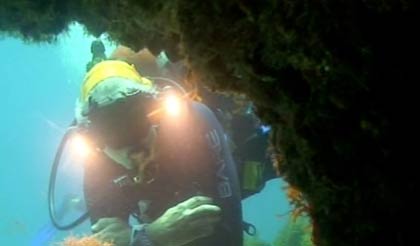
Bottom line: Liquid Image Wide Angle Scuba Series HD322
The Liquid Image Scuba Series mask is a totally unique product that fills many needs. It's fun, interesting, and a guaranteed conversation starter that seems to fascinate people to no end. But although it has a novelty look, it's actually a meticulously designed and engineered product that works amazingly well. The combination of a flexible CMOS image sensor and H.264 video compression means you can store hours of video on a microSDHC storage card. The mask is capable of taking decent pictures and very good 720p high-def video, but for best results you need to learn how to use it, and you need a lot of light.
At about US$350, the Scuba Series Wide Angle HD322 mask costs no more than high-end waterproof point-and-shoot cameras and much less than cameras with separate underwater housing, and with the camera part of the mask, you can shoot underwater pictures and video without having to carry a camera. This means you have your hands free for other things and don't have the added water resistance from holding a camera. The mask part of the video mask is good enough to replace a conventional scuba mask. And the camera part is well enough integrated so that you're hardly aware of it. Use it to take pictures, video, or to document entire dives. The opportunities are limitless.
We really like the much wider recording angle of the HD322 that makes it so much easier to capture subjects. The 135 degree angle means there's some fisheye distortion, but that's hardly noticeable under water.
Since you can never have enough light, we highly recommend the (separately sold) terrific LED torch lights that attach to the mask. You'll be amazed at all the colors you'll see in the bright, even cone of light from the torches, and if you dive caverns or wrecks, these lights are a total revelation.
We like:
- Combines a still/video camera with a very good quality scuba mask
- Rated waterproof to 130 feet, and can easily handle that
- Much wider 135 degree recording angle a huge improvement
- Camera does not get in the way
- Super-simple operation
- Uses microSDHC cards up to 32GB (we tested with 8GB and 16GB cards)
- H.264 compression means a full hour of video takes just 2GB
- Good video, especially when there is enough light
- Excellent for documenting dives
- Less expensive than separate camera and housing
- Optional head-mount torch lights fantastic
Some drawbacks:
- Difficult to keep head still and bubbles out of the way
- Anything but optimal lighting reduces video quality and makes taking usable stills very difficult
- Status LCD and icons very small
- Should focus closer than 1.7 feet
- Uses costly Lithium AAA batteries
Liquid Image Co, LLC
5610 Skylane Blvd Suite D
Santa Rosa, CA 95403, USA
Ph: (707) 284-1585
Fax: (707) 284-1592
sales@liquidimageco.com
www.liquidimageco.com
|










